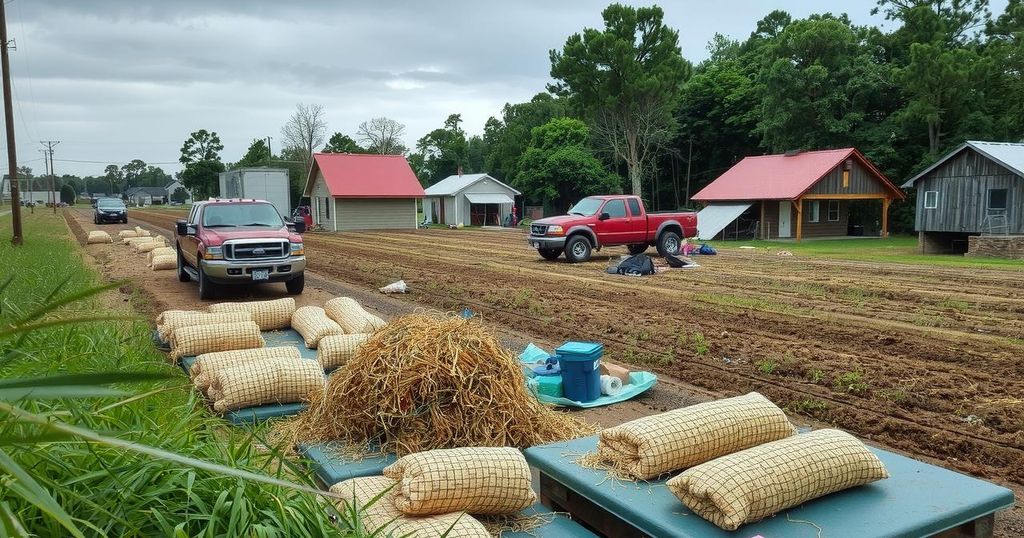Georgia farmers are confronting over $5.5 billion in losses due to Hurricane Helene, which struck in late September 2023. The Category 4 storm caused widespread damage to crops, especially cotton, and extensively impacted infrastructure. As farmers like Chris Hopkins face emotional and financial burdens, state and federal assistance become crucial for recovery. Experts predict minimal effects on consumer prices, although pecan production may experience significant consequences.
Georgia farmers continue to grapple with extensive losses exceeding $5.5 billion following the devastation caused by Hurricane Helene. More than two months after the storm’s arrival in late September, challenges remain evident on farms, where essential equipment lies damaged and crops are severely affected. Farmers like Chris Hopkins are left contemplating their future, facing emotional and financial strain as they endeavor to recover from the aftermath of such a disastrous event.
The storm, which originated as a powerful Category 4 hurricane in Florida, caused widespread destruction across several Southern states, with damages expected to total over $10 billion. Key losses include not only crops and timber but also significant damage to poultry facilities, which are critical to Georgia’s agricultural landscape. The impact on farmers was especially severe, coinciding with the pivotal cotton harvest season, leading to substantial crop losses and affecting livelihoods for many.
The University of Georgia’s analysis indicates that Georgia alone incurred at least $5.5 billion in storm-related losses, exacerbating the challenges posed by already low cotton prices that hovered around 70 cents per pound. Farmers have initiated cleanup and recovery efforts, yet the emotional toll of the hurricane lingers. As state and federal governments mobilize to provide assistance, the nature of support required remains urgent, with farmers expressing the need for swift aid as they begin to rebuild their operations. Notably, issues surrounding insurance coverage add to the existing difficulties, with assessments indicating that many farmers will not be fully compensated for their losses.
Despite these challenges, market experts assert that consumer prices may not see significant fluctuations, primarily due to existing agricultural outputs from other regions that can offset local shortages, although pecan prices could be an exception given Georgia’s prominence in national production. Overall, the road to recovery for Georgia’s agricultural sector will be long and arduous, invoking a collective response from both local communities and government bodies to assist farmers in navigating this tumultuous period.
Hurricane Helene made landfall on September 26, 2023, as a Category 4 storm, wreaking havoc across the Southern United States, particularly impacting Georgia’s farming communities. With the storm landing during the crucial cotton harvest season, farmers were caught unprepared and suffered substantial crop damage along with losses to infrastructure and equipment. The agriculture sector, critical to Georgia’s economy, is facing a recovery period marked by significant financial losses, emotional distress, and the urgent need for assistance, as many individuals depend on these farming operations for their livelihoods. Prior storms, such as Hurricane Michael in 2018, have already strained the agricultural sector, intensifying the challenge for farmers this year.
In summation, Georgia farmers are enduring a severe financial crisis as a result of Hurricane Helene, with losses estimated at over $5.5 billion. The storm’s detrimental impact extends beyond lost crops to include damaged equipment and infrastructure, forcing farmers to reconsider their futures. While there are efforts from both state and federal governments to provide assistance, the process of recovery and rebuilding will prove to be a formidable task. The overall resilience of the farming community remains pivotal as they navigate the aftermath of this catastrophe. The agriculture sector’s long-term stability relies on swift and effective relief efforts as farmers attempt to restore their operations and livelihoods.
Original Source: ktxs.com






